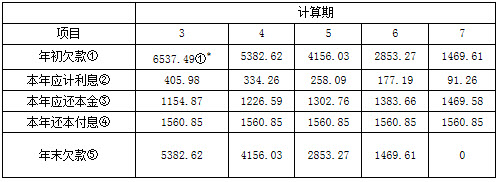某咨询公司正准备进行一工业项目的财务评价,有关资料及数据如下:
(1)建筑工程费用估算为500万元。
(2)项目计划采用进口设备,设备重1200吨,离岸价为450万美元,国外运费标准为 350美元/吨,国外运输保险费费率为2.66‰,中国银行财务费费率为5‰,外贸手续费费率为1.5%,关税税率为22%,增值税的税率为17%,美元的银行牌价为6.8元人民币,没备的国内运杂费率为2.5%。
(3)项目的工具、器具及生产家具费为300万元。
(4)安装工程费为500万元。
(5)工程建设其他费按工程费的24%计算。基本预备费率取5%。
(6)项目分两年进行投资,工程费用的投入比例分别为55%、45%。预计建设期间的价格上涨率为6%。
(7)项目部分建设投资采用银行借款,第一年贷款额为2500万元,第二年贷款额为 3500万元。贷款年初发放,银行利率取6.21%。与银行约定,从生产期的第—年开始还款,按5年等额还本付息方式偿还。
计算项目生产期的应还本金和应计利息。
参考答案:
解:运营期期初(即计算期第三年年初)的还本付息总额①*=2500+3500+537.49=6537.49(万元)
每年还本付息额④=6537.49×(A/F,6.21%,5)=1560.85(万元)
项目生产期的应还本金和应计利息的计算如表4—2所示(单位:万元)。
表4-2 借款还本付息计算表

说明:
①=上一年年末欠款额
②=①×银行利率(6.21%)
③=④-②
⑤=①-③
